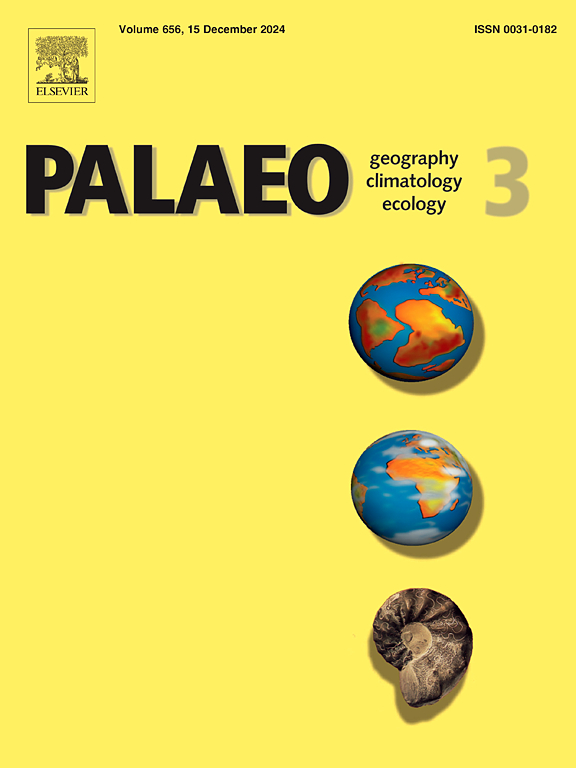土耳其安纳托利亚中部白垩纪-古近纪界线的认识:一个综合的多代理研究
IF 2.7
2区 地球科学
Q2 GEOGRAPHY, PHYSICAL
Palaeogeography, Palaeoclimatology, Palaeoecology
Pub Date : 2025-07-20
DOI:10.1016/j.palaeo.2025.113149
引用次数: 0
摘要
土耳其中部安纳托利亚Mudurnu-Göynük盆地拥有白垩纪-古近纪过渡的完整记录。对Göynükw和okular两个地层剖面进行了高分辨率测井,并采用微古生物学、矿物学和地球化学方法进行了分析。微体古生物学分析鉴定出最上层马氏浮游有孔虫生物带CF1 (Plummerita hantkeninoides)和最下层大年生物带P0、Pα、P1a、P1b和P1c。白垩纪-古近纪界线(KPB)在这两个地点对应着大型、有孔虫(如Globotruncana、Racemiguembelina、Planoglobulina)的急剧灭绝,碳氧同位素比值(δ13Ccarb和δ18Ocarb)的负移,方解石和蒙脱石含量减少,石英、层状硅酸盐、高岭石和伊立石含量增加,汞(Hg)、碲(Te)和微量元素含量达到峰值。磁化率值在整个Maastrichtian CF1区呈连续下降趋势,且在KPB前下降速度加快,与Hg和Te含量的增加一致。这种磁化率值的加速下降可能对应于形成Poladpur组的德干大喷发之一。新的数据集表明,环境变化始于马斯特里赫特最上层,并在KPB达到顶峰。整个生态系统的恢复可能发生在大浮游有孔虫的重新出现和δ13Ccarb值与大浮游有孔虫之前相似的数十万年后。本文章由计算机程序翻译,如有差异,请以英文原文为准。
Insights into the Cretaceous-Paleogene boundary in Central Anatolia, Turkey: A comprehensive multi-proxy study
The Mudurnu-Göynük Basin, Central Anatolia, Turkey, hosts a complete record of the Cretaceous-Paleogene transition. Two stratigraphic sections, Göynükw and Okçular, were logged at high resolution and analyzed using micropaleontological, mineralogical, and geochemical methods. The micropaleontological analysis allowed the identification of the uppermost Maastrichtian planktonic foraminiferal biozone CF1 (Plummerita hantkeninoides) and the lowermost Danian biozones P0, Pα, P1a, P1b, and P1c. The Cretaceous-Paleogene boundary (KPB) at both sites corresponds to a sharp extinction of the large, ornate planktonic foraminifera (e.g., Globotruncana, Racemiguembelina, Planoglobulina), negative shifts in carbon and oxygen isotope ratios (δ13Ccarb and δ18Ocarb), decreases in calcite and smectite contents, increases in quartz, phyllosilicates, kaolinite and illite contents, peaks in mercury (Hg), tellurium (Te) and trace element contents. Furthermore, magnetic susceptibility values decrease continuously throughout the Maastrichtian CF1 Zone, and this decrease even accelerates before the KPB, coinciding with an increase in Hg and Te contents. This accelerated decline in magnetic susceptibility values may correspond to one of the major Deccan eruptions that formed the Poladpur Formation. The new dataset suggests that environmental change began in the uppermost Maastrichtian and culminated in the KPB. The total ecosystem recovery may have occurred a few hundred thousand years after the KPB, as supported by the reappearance of the larger planktonic foraminifera and δ13Ccarb values similar to those before the KPB.
求助全文
通过发布文献求助,成功后即可免费获取论文全文。
去求助
来源期刊
CiteScore
5.90
自引率
10.00%
发文量
398
审稿时长
3.8 months
期刊介绍:
Palaeogeography, Palaeoclimatology, Palaeoecology is an international medium for the publication of high quality and multidisciplinary, original studies and comprehensive reviews in the field of palaeo-environmental geology. The journal aims at bringing together data with global implications from research in the many different disciplines involved in palaeo-environmental investigations.
By cutting across the boundaries of established sciences, it provides an interdisciplinary forum where issues of general interest can be discussed.

 求助内容:
求助内容: 应助结果提醒方式:
应助结果提醒方式:


